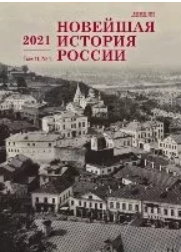Советские горожанки в годы хрущевской оттепели глазами англоязычных авторов
Soviet Women in the Years of the “Khrushchev’s Thaw” in English Language Publications
Author(s): Natalia Lvovna Pushkareva, Alexander V. ZhidchenkoSubject(s): Social history, Gender history, Post-War period (1950 - 1989), Politics of History/Memory
Published by: Издательство Исторического факультета СПбГУ
Keywords: everyday life; women’s history; gender approach; Khrushchev; thaw; USSR; Cold War; consumption;
Summary/Abstract: The article assesses the results of studies of everyday lives of Soviet women in the 1950s–1960s in Anglo-American historiography, in which a problematic field has developed with its own boundaries, plots and search tasks, and a well-established range of sources. The peculiarity of Western scholars’ views of this issue were of considerable importance for biographical interviews, the stories of women who remember that time. (In contrast to Russian historiography, foreign scholars used an anthropological approach to study women’s history much earlier.) The authors define more clearly the successes of foreign scholars in the study of Soviet women’s history in the 1960s, as well as controversial assessments and prospects. Considered chronologically and sequentially, the assessments of Soviet life in the publications of English-speaking scholars revealed their strong dependence on the American model of everyday life for the corresponding period. The consumption system and social protection of the population, which grew sharply after the Second World War in Western countries, became the ideal that guided these scholars during the entire second half of the twentieth century. In such a comparison, Soviet women’s lives in conditions of constant deficits of goods and services, as well as other problems and shortcomings of the Soviet economic model, always seemed to be a losing battle. In the 2000s, this ideal model of American everyday life, with which scholars did not directly compare women’s everyday lives in the USSR, but which between the lines manifested itself as a standard, turned out to be somewhat squeezed by the desire to positively evaluate the achievements of Soviet social policy and the gains that it provided for women.
Journal: Новейшая история России
- Issue Year: 11/2021
- Issue No: 36
- Page Range: 776-791
- Page Count: 16
- Language: Russian

